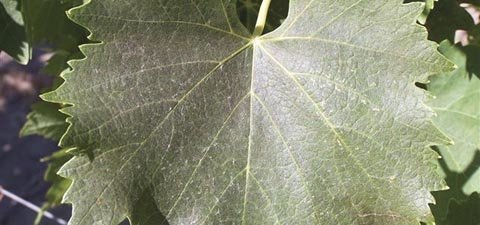
Bronzing of grape leaves in the summer is a telltale sign of grape rust mite. (Photo courtesy of Washington State University)
Wine grape growers in Mattawa and the Yakima and Columbia Valleys were concerned in the summer of 2005 to find their vine leaves turning a bronze color. In extreme cases, the leaves turned black and dropped prematurely.
A researcher at Washington State University’s Irrigated Agriculture Research and Extension Center in Prosser said the damage was caused by grapeleaf rust mites, a pest that may have been present for a while before being detected last year.
Dr. David James, entomologist at the center, said that while such leaf damage looks serious, it has little effect on vine productivity and health if the mites are detected early and managed with timely applications of sulfur.
“People get alarmed when they see the leaves going brown,” he said, “but there’s nothing to be alarmed about.”
The grapeleaf rust mite is one-tenth the size of the more familiar, and more destructive, spider mite that has plagued state vineyards, James said. The rust mite is difficult to see even with a magnifying glass.
“You see the damage before you see the mite,” he said. “It’s not causing a problem at that point (in the summer); the fruit has already set. Spring time is when the damage is caused.”
The mites, however, appear populous enough to cause significant damage in the spring, he said.
If unchecked by predators or chemicals, the mites emerge from their winter shelters in vine bark and gather on new shoots and can restrict spring growth. Shoots and leaves crinkle, affecting vine growth and production.
Found in Oregon
James said the rust mite was discovered in 2004 in Oregon, where it is apparently attracted to the more plentiful organic crops grown there.
Although the mites have done little damage in Washington vineyards, he said that could change if they’re not managed correctly and their numbers are allowed to swell. “In the plants where it’s been around in large numbers, the mite has caused significant damage.”
Browning of summer leaves is a good indication of a future problem, he said.
One possible reason the mite has gone undetected until now, he added, is that herbicides caused similar damage in the past.
A lot of problems that growers have had were caused by too much spraying, he said. “Too much sulfur kills predators.
“Now that they’ve backed off on the chemicals, the appearance of the mite means we’re going the right way. People may not have realized the damage was caused by mites. They might have attributed it to herbicides.”
If rust mites are managed appropriately, James said, they can actually be beneficial. They may actually enhance biological control of spider mites by providing a new and significant food source for predatory mites that feed on their smaller cousins, encouraging the population growth of these beneficial mites.
“Predatory mites do the best job of controlling smaller mites,” he said. “We’re looking for funding from the grape industry to research better controls. We’re trying to make the system more stable.”
James said infestations can be managed with a timely, high-volume application of sulfur (4.5 to 6.0 pounds per acre) during the time mites are migrating from the trunk to the buds. In most grape varieties, this is during the beginning of bud swell. Spraying must take place in temperatures above 60° F.
James said a similar mite, the grape bud mite, also is appearing in state vineyards. This mite spends most of its life inside grape buds, killing the buds, stunting shoot growth, or both.
Sulfur spraying is only effective during a seven- to ten-day period after bud burst, when the mites are migrating from overwintered buds to next season’s primordial buds.
James emphasized that these two species haven’t shown up in all Washington vineyards yet. Treatments aren’t necessary unless there are stunted shoots and crinkled leaves in the spring or summer or summer bronzing of leaves.

Leave A Comment